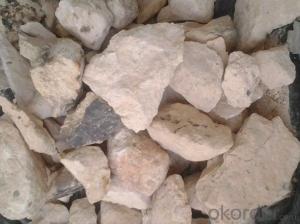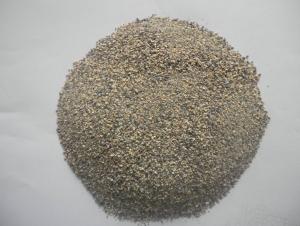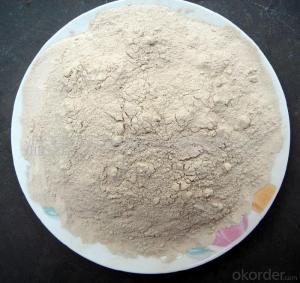Raw Materials for Refractory:Refractory Grade Calcined Bauxite of CNBM in China
- Loading Port:
- Tianjin
- Payment Terms:
- TT OR LC
- Min Order Qty:
- 11 m.t.
- Supply Capability:
- 10000000 m.t./month
OKorder Service Pledge
OKorder Financial Service
You Might Also Like
Refractory Grade Calcined Bauxite of CNBM in China
1.Structure of Calcined Bauxite Description
Calcined bauxite is one of the principal ore of aluminum. Calcined bauxite contains hydrous aluminum oxides and aluminum hydroxides, formed through the laterization of aluminous rocks in tropical and subtropical areas . Calcined bauxite is obtained by calcining (heating)superior grade bauxite at high temperature (from 85OC to 1600C) .this can removes moisture thereby increasing the alumina content. Compared to an alumina content of about 57%to 58% in raw bauxite, calcined bauxite has an alumina content of 75% to 90%.
2.Main Features of the Calcined Bauxite
Calcined bauxite is one of the principal ore of aluminum. Calcined bauxite contains hydrous aluminum oxides and aluminum
hydroxides, formed through the laterization of aluminous rocks in tropical and subtropical areas .Calcined bauxite is obtained by calcining (heating)superior grade bauxite at high temperature (from 85OC to 1600C) .This removes moisture there. By increasing the alumina content,compared to an alumina content of about 57%to 58% in raw bauxite, calcined bauxite has an alumina content of 84%to88%.The heating is carried out in rotary kilns.
3.Main usage of the Calcined Bauxite
1) The bauxite for aluminum industry in defense, aerospace, automotive, electrical, chemical, and daily supplies; 2) Bauxite clinker processed into fine powder and made after the casting mold. Used in military, aerospace, communications, instrumentation, machinery and medical equipment sector; 3) The bauxite can be used in refractory products. The refractoriness of high-alumina clinker is up to 1780 . Its features are chemical stability strong, and physical properties of sound; 4) It can manufact alumina cement, abrasive materials and aluminum compounds.
4. Calcined Bauxite Images


5. Calcined Bauxite Specification
Item | Al2O3 (min) | Fe2O3 (max) | TiO2 (max) | SiO2 (max) | KO2+NaO2 (min) | CaO+MgO (min) | Bulk Density(g/cm3) |
70 | 70% | 2.5% | 2.9min | ||||
75 | 75% | 3.0% | 4.0% | 8% | 0.3% | 0.6% | 2.7min |
80 | 80% | 3.0% | 4.0% | 8% | 0.3% | 0.6% | 2.8min |
85 | 85% | 2% | 4.0% | 8% | 0.3% | 0.6% | 3.0min |
86 | 86% | 2% | 4.0% | 8% | 0.3% | 0.6% | 3.2min |
87 | 87% | 2% | 4.0% | 7% | 0.3% | 0.6% | 3.2min |
88 | 88% | 1.8% | 4.0% | 7% | 0.25% | 0.6% | 3.25min |
90 | 90% | 1.8% | 4.0% | 7% | 0.25% | 0.6% | 3.25min |
1) Al2O3≥83%
2) Fe2O3≤2.0%
3) K2O+Na2O≤0.6%
4) B.D.≥3.10/cm3
5) Water Absorption≤4.5%
6) Sizes: Lumps /Grains:0-1mm,1-3mm,3-5mm,5-8mm /Powders:100mesh, 200mesh,325mesh
6.FAQ of Calcined Bauxite
1). Q: Are you a factory or trading company?
A: We are a factory.
2). Q: Where is your factory located? How can I visit there?
A: Our factory is located in ShanXi, HeNan, China. You are warmly welcomed to visit us!
3). Q: How can I get some samples?
A: Please connect me for samples
4). Q: Can the price be cheaper?
A: Of course, you will be offered a good discount for big amount.
- Q: Does anyone know the characteristics of refractory for glass kiln?
- Refractory is a kind of non-metallic material with refractoriness not less than 1580 ℃, which has better thermal shock resistance and chemical erosion resistance, low heat conductivity coefficient and low expansion coefficient. Refractoriness is the centigrade?temperature of refractory cone specimen wiyhout any load resisting high temperatures without melting down Refractory is widely used in industries like metallurgy, chemical, petroleum, machinery manufacturing, silicates, power, etc., which is mostly used in the metallurgical industry, accounting for 50% to 60% of total output.
- Q: What kinds of fireproof and fire retardant materials are there?
- fireproof materials are mainly non-combustible A material and flame retardant B1materials. Class A non-combustible material: Granite, marble, terrazzo, cement products, concrete products, plasterboard, lime products, clay, glass, tiles, mosaics, steel, aluminum, copper alloy; B1 grade flame retardant materials: Ceiling materials gypsum board, gypsum fiber boards, cement particle board, mineral wool acoustic panels, glass wool decorative acoustic board, perlite decorative acoustic board, flame retardant plywood, medium density fiberboard flame, rock wool decorative panels, retardant wood, aluminum composites, flame retardant phenolic plywood, aluminum foil, glass fiber reinforced plastic composite materials; wall materials gypsum board, gypsum fiber boards, cement particle board, mineral wool board, glass wool board, perlite board, flame retardant plywood, retardant MDF, fireproof plastic decorative plates, flame-sided particleboard, colorful paint, flame retardant wallpaper, wall covering flame retardant, flame imitation granite decorative plates, magnesium oxychloride cement prefabricated wall panels, flame retardant glass fiber reinforced plastic plate, PVC plastic sheeting, high-strength lightweight composite panels, fire-retardant molded wood composite board, color retardant plywood, fiberglass and other flame retardant.
- Q: What are grade classifications of the external walls fireproofing material?
- 1. The thermal insulation material of level A combustion performance: Rock wool, glass wool, foam glass, foamed ceramics, foam cement, hole-closed perlite, etc. 2. combustion performance is level B1 insulation materials: Extruded polystyrene board (XPS) after special treatment / Special treatment of polyurethane (PU), phenolic aldehyde and gelatine powder polyphenyl granule 3, combustion performance is level B2 insulation material: Molding polystyrene board (EPS), extruded polystyrene board (XPS), polyurethane (PU), polyethylene (PE), etc. See the 2009 edition construction technical measures 4.3.6 Level A insulation material is only for fireproofing, but its thermal insulation performance is not better than organic XPS \\ EPS and other materials.
- Q: Urgent question: could you tell me that the export of refractory materials to Vietnam is to be packed in wooden cases and smoked?
- Strictly speaking, as long as there are solid wood packaging, you need to do fumigation inspection, proved not necessarily used, there are IPPC chapters on it.
- Q: What kinds of refractory will be used in kiln of sintering ceramics?
- High alumina brick, clay brick, insulating brick and silicon carbide plate.
- Q: About the market issues of thermal insulation material and refractory material.
- In fact, the thermal insulation material produced by the Sichuan-Benniao Hing construction company is very good, you can get the company's information just by inputing the Sichuan-Benniao Hing construction company into Baidu
- Q: What are the construction measures of refractory material in winter? Please descriptive briefly.
- The temperature is low in winter, so refractory bulk materials should be stirred evenly on time to avoid freezing.
- Q: How to classify the grade of wall fireproof and thermal inuslation matertial?
- To sum up three versions of GB8624 (1997, 2006, 2011), fire?rating of external wall thermal insulation can be basically divided into: A1, A2, B1, B2, B3 and other levels. Specific division has many technical indicators to judge. It can't be said for a moment. It is very professional and technical. For details, please contact Qingdao Shanfang Instrument. They specialized in tester of fire?rating of external wall thermal insulation materials.
- Q: What are the filling refractories in door leaf of class A fire resistant door?
- Perlite!
- Q: How many fire endurance grades are the AAA fire resisting shutter divided?
- According to the fire endurance, the fire doors can be divided into Class A, Class B and Class C fire doors with the fire resistances are not less than 1.20h, 0.90h and 0.60h. Even the fire resistant level of B can also use the first rate fire resistant door.
Send your message to us
Raw Materials for Refractory:Refractory Grade Calcined Bauxite of CNBM in China
- Loading Port:
- Tianjin
- Payment Terms:
- TT OR LC
- Min Order Qty:
- 11 m.t.
- Supply Capability:
- 10000000 m.t./month
OKorder Service Pledge
OKorder Financial Service
Similar products
Hot products
Hot Searches
Related keywords
































